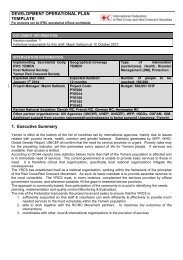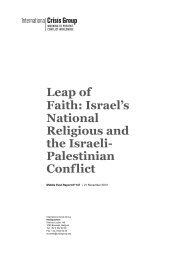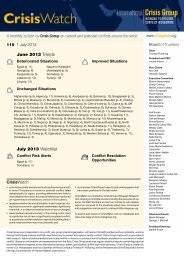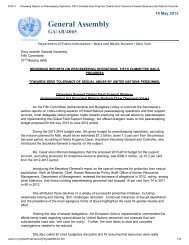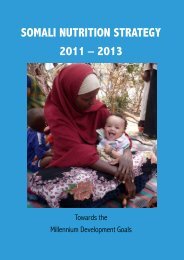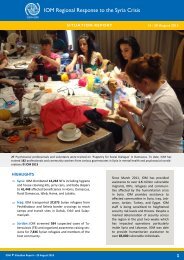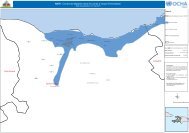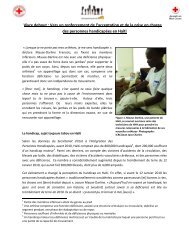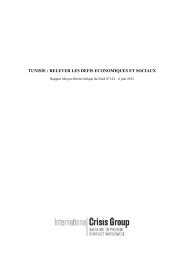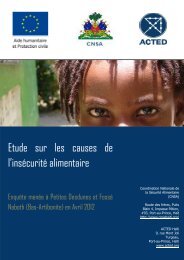issues for consideration at the berlin donor conference ... - ReliefWeb
issues for consideration at the berlin donor conference ... - ReliefWeb
issues for consideration at the berlin donor conference ... - ReliefWeb
You also want an ePaper? Increase the reach of your titles
YUMPU automatically turns print PDFs into web optimized ePapers that Google loves.
10 THE ROAD AHEAD<br />
REFUGEES AND INTERNALLY DISPLACED PERSONS (IDPS)<br />
St<strong>at</strong>us Report<br />
Afghans comprise <strong>the</strong> second largest number of refugees and IDPs in <strong>the</strong> world; it is estim<strong>at</strong>ed th<strong>at</strong><br />
one of every three Afghans was a refugee or an IDP <strong>at</strong> one time. Since <strong>the</strong> fall of <strong>the</strong> Taliban<br />
regime in 2001, <strong>the</strong> Ministry of Refugees and Rep<strong>at</strong>ri<strong>at</strong>ion (MoRR), 55 working with <strong>the</strong> UN High<br />
Commissioner <strong>for</strong> Refugees (UNHCR), has facilit<strong>at</strong>ed <strong>the</strong> return of 2.4 million Afghans, mostly<br />
from Pakistan and Iran. 56 600,000 IDPs have also returned to <strong>the</strong>ir areas of origin. Despite this<br />
progress, approxim<strong>at</strong>ely 3.4 million Afghan refugees and 200,000 IDPs have yet to return. The<br />
dram<strong>at</strong>ic surge in popul<strong>at</strong>ion has <strong>the</strong> potential to c<strong>at</strong>alyze health, food and security crises.<br />
Problems<br />
Security<br />
Many returnees are refusing to return to <strong>the</strong>ir n<strong>at</strong>ive areas, citing insecurity, <strong>the</strong> lack of land to which<br />
to return, and potential ethnic conflict or tension. Forty-five percent of returning refugees went to<br />
central Afghanistan; 22 percent went to nor<strong>the</strong>rn Afghanistan; and 21 percent went to <strong>the</strong> eastern<br />
part of <strong>the</strong> country. Returns to <strong>the</strong> sou<strong>the</strong>rn and sou<strong>the</strong>astern regions of Afghanistan have been<br />
lower than all o<strong>the</strong>r areas of Afghanistan, reflecting <strong>the</strong> poor security situ<strong>at</strong>ion in those areas.<br />
Urban S<strong>at</strong>ur<strong>at</strong>ion<br />
Overall, 42 percent of returning refugees have settled in urban areas, where <strong>the</strong>re are more health<br />
centers, schools, and job opportunities. 750,000 Afghans have flooded into Kabul in <strong>the</strong> past 18<br />
months, and Kabul’s popul<strong>at</strong>ion has doubled to 3 million people over <strong>the</strong> past two years. Urban<br />
areas throughout <strong>the</strong> country have almost reached s<strong>at</strong>ur<strong>at</strong>ion.<br />
Inadequ<strong>at</strong>e Financial Support<br />
Returnees requesting rep<strong>at</strong>ri<strong>at</strong>ion assistance through UNHCR are registered <strong>at</strong> Voluntary<br />
Rep<strong>at</strong>ri<strong>at</strong>ion Centers (VRCs) established throughout Pakistan and Iran. Upon registr<strong>at</strong>ion, <strong>the</strong><br />
returnee receives a Voluntary Rep<strong>at</strong>ri<strong>at</strong>ion Form, which is used to secure a transport grant upon<br />
arrival in Afghanistan. In addition, children are inocul<strong>at</strong>ed, and an aid kit is provided to families.<br />
According to Amnesty Intern<strong>at</strong>ional, <strong>the</strong> cash grant is not sufficient to cover returnees’ travel, and as<br />
a result, it has been difficult, if not impossible, <strong>for</strong> refugees to return to <strong>the</strong>ir home areas. 57 UNHCR<br />
reports th<strong>at</strong> <strong>the</strong> VRCs are functioning smoothly and efficiently, but th<strong>at</strong> funding is lacking <strong>for</strong> longterm<br />
economic aid to help returnees enhance <strong>the</strong>ir livelihood.<br />
55 The Ministry of Refugees and Rep<strong>at</strong>ri<strong>at</strong>ion’s priorities are: 1) Refugee and IDP rep<strong>at</strong>ri<strong>at</strong>ion and return; 2) Assistance<br />
to <strong>the</strong> residual IDP popul<strong>at</strong>ion; 3) Initial returnee reintegr<strong>at</strong>ion; 4) Refugee and IDP protection and social services, and<br />
5) Refugee and IDP capacity.<br />
56 Amnesty Intern<strong>at</strong>ional has reported th<strong>at</strong> Pakistan and Iran are increasingly experiencing asylum f<strong>at</strong>igue, <strong>for</strong>cing<br />
refugees to rep<strong>at</strong>ri<strong>at</strong>e and closing borders to incoming refugees. “Afghanistan: Out of Sight, Out of Mind: The F<strong>at</strong>e of<br />
<strong>the</strong> Afghan Returnees,” Amnesty Intern<strong>at</strong>ional report, June 2003,<br />
(accessed<br />
November 25, 2003) [hereinafter “Amnesty Intern<strong>at</strong>ional report”].<br />
57 Amnesty Intern<strong>at</strong>ional report.




